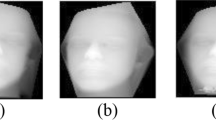Abstract
In this article, we propose a shift-invariant pattern recognition mechanism using a feature-sharing hypercolumn model (FSHCM). To improve the recognition rate and to reduce the memory requirements of the hypercolumn model (HCM), a shared map is constructed to replace a set of local neighborhood maps in the feature extraction and feature integration layers. The shared maps increase the ability of the network to deal with translation and distortion variations in the input image. The proposed face recognition system employed a FSHCM neural network to perform feature extraction and use a linear support vector machine for a recognition task. The effectiveness of the proposed approach is verified by measuring the recognition accuracy using the misaligned ORL face database.
Similar content being viewed by others
References
Heisele B, Serre T, Pontil M, et al (2002) Categorization by learning and combining object parts. Adv Neural Inf Process Syst 14(2):1239–1246
Fukushima K (1980) Neocognitron. Biol Cybern 36(4):193–202
Serre T, Wolf L, Bileschi S, et al (2007) Robust object recognition with cortex-like mechanisms. IEEE Trans Pattern Anal Mach Intell 29(3):411–426
Hubel D, Wiesel T (1962) Receptive fields, binocular interaction and functional architecture in the cat’s visual cortex. J Physiol 160:105–154
Tsuruta N, Taniguchi R, Amamiya M (2000) Hypercolumn model: a combination model of hierarchical self-organizing maps and neocognitron for image recognition. Syst Comput Jpn 31(2):49–61
Kohonen T (1997) Self-organizing maps. Springer, Berlin
Lampinen J, Oja E (1992) Clustering properties of hierarchical self-organizing maps. J Math Imaging Vision 2(2–3):261–272
Sammaria F, Harter A (1994) Parameterization of a stochastic model for human face identification. 2nd IEEE Workshop on Applications of Computer Vision Sarasota, FL, pp 138–142
Turk M, Pentland A (1991) Face recognition using Eigenfaces. J Cog Neurosci 19(7):71–86
Belhumeur P, Hespanha J, Kriegman D (1997) Eigenfaces vs. Fisherfaces: recognition using class-specific linear projection. IEEE Trans PAMI 19:711–720
Author information
Authors and Affiliations
Corresponding author
Additional information
This work was presented in part at the 14th International Symposium on Artificial Life and Robotics, Oita, Japan, February 5–7, 2009
About this article
Cite this article
Aly, S., Tsuruta, N. & Taniguchi, Ri. Feature map sharing hypercolumn model for shift invariant face recognition. Artif Life Robotics 14, 271 (2009). https://doi.org/10.1007/s10015-009-0669-y
Received:
Accepted:
Published:
DOI: https://doi.org/10.1007/s10015-009-0669-y




